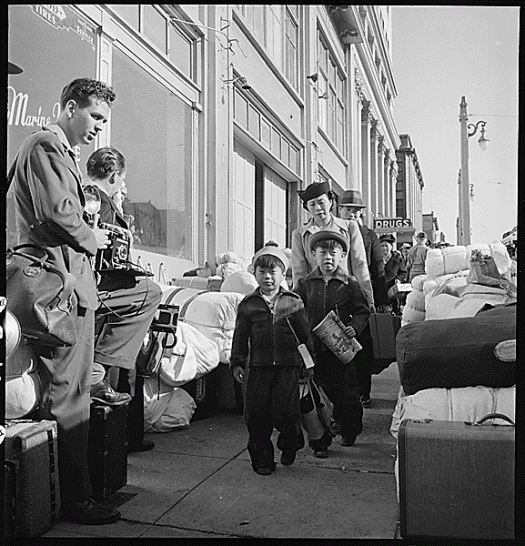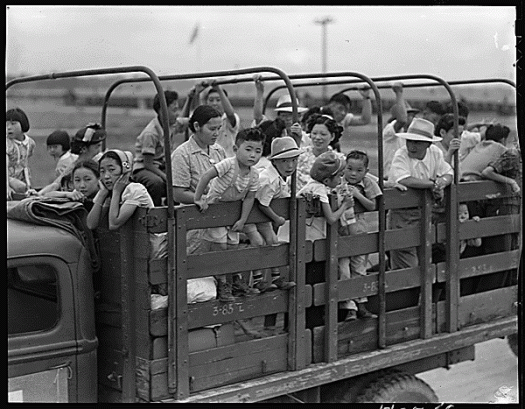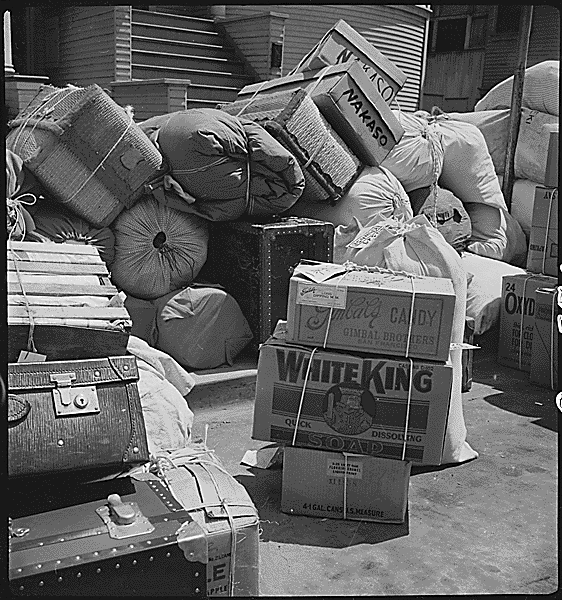Silence and Suppression: The Mass Incarceration of Japanese Americans
Has the Gestapo come to America? Have we not risen in righteous anger at Hitler’s mistreatment of Jews? Then, is it not incongruous that citizens of Americans of Japanese descent should be similarly mistreated and persecuted? – James Omura, testimony before Select Committee Investigating National Defense Migration, February 23, 1942
I’m inspired to write this post after a Twitter conversation with Dr. Tamara Nopper yesterday. I’ve spent a good chunk of this year reading and learning about the mass incarceration of Japanese Americans during World War II. Last year, I wrote briefly about my interest in educating myself about this chapter in U.S. history. I’ve been stunned at how little I actually know.

San Francisco, California. Many news photographers were present for the first contingent of evacuee 04/06/1942, photo by Dorothea Lange (NARA)
John Kwo Wei Tchen has described the imprisonment of over 120,000 Japanese Americans during World War II as “vigilante Americanism.” This characterization rings true. As I’ve read, I’ve noticed the many silences in the telling and re-telling of this history. I’ve pondered the trauma and unspoken grief that permeate the accounts of this forced removal to American concentration camps. Yet it appears that most of the country remains largely unaware about this heinous chapter in American history. Why is this?
Thousands of people (70% of them native born citizens) were falsely accused and incarcerated for crimes that they didn’t commit under the guise of national security. As a Muslim American, I can’t help but find eerie similarities between 1942 and post-2011 America. By the end of the war, over 120,000 Japanese Americans had been uprooted and incarcerated in concentration camps located in Arizona, Arkansas, California, Colorado, Idaho, Texas, Utah and Wyoming.

Closing of the Jerome Relocation Center, Denson, Arkansas. A typical truck load of Jerome residents waiting to be put on the train for transfer to the Gila River Center. 06/13/1944 –
Charles E. Mace, photographer (NARA)
I have twice used the term “concentration camps” which is bound to make many uncomfortable. Yet this is what they were. Part of how the history of Japanese internment and incarceration in the U.S. has been disappeared is by the reliance on a language of euphemism. We call prisoners “evacuees” and concentration camps “relocation camps.” This obscures the truth and minimizes the horror. How can we address the magnitude of injustice by relying on language that suppresses reality? I believe in the importance of calling things what they actually are. After all, both Presidents Roosevelt and Truman referred to the “concentration camps” where Japanese Americans were incarcerated.
This photograph of Eleanor Roosevelt “touring” the Gila River jail (adjustment center) is one that I have seen many times. However, the more I read, the more obscene this photograph appears. It was taken exactly a year after her husband, President Franklin D. Roosevelt, had issued one of the most vile executive orders in history.
The actual process of incarcerating thousands of people was complicated:
“It began even before the issuing of Executive Order 9066, immediately after Pearl Harbor was bombed, with the arrest of hundreds of Issei who were primarily community leaders. These Issei, along with selected German and Italian nationals, were arrested and detained in internment camps by the U.S Justice Department.
Executive Order 9066 mandated that people of Japanese ancestry living in areas designated by the military’s Western Defense Command, which essentially constituted America’s entire West Coast, were subjected to curfew and restriction of movement. They were forced to quickly dispose of their homes, businesses, and belongings and report to so-called assembly centers. These centers were hastily converted facilities such as fairgrounds and race tracks, where families were held from one to seven months. (source: Lost & Found: Reclaiming the Japanese American Incarceration by Karen L. Ishizuka, 2006, pp.70-71)”

Photograph of Baggage Belonging to Evacuees of Japanese Ancestry Ready to Be Loaded into Moving Vans, 05/06/1942 (NARA)
After months in these “assembly” centers, over 100,000 men, women and children were then incarcerated in concentration camps for periods that lasted from months to years. Besides the emotional loss and physical violence, the Japanese American community is said to have suffered economic losses in excess of $250 million as a result of their incarceration.
The Civil Rights Act of 1988 compelled the government to make a formal apology for the violation of the rights of Japanese Americans and also awarded $20,000 each to more than 80,000 survivors of the concentration camps. I guess that for some people this means that we should close the books and move on. I think that we need to do more to educate Americans about this grave injustice and we need to be focused on the ways that we continue to criminalize entire groups of people today under the guise of national security threats.

